Student Loan Pause Extension: Biden Confirms Payments Won't Resume Until September

Nearly 40 million student loan borrowers can breathe a sigh of relief.
President Joe Biden announced Wednesday that his administration is extending the student loan moratorium until Aug. 31, against a backdrop of record-setting inflation, whispers of an impending recession and yet another wave of COVID-19 infections.
The student loan moratorium freezes student loan payments and sets the loan interest rate to 0%. Payments were slated to restart May 1, though polls found borrowers weren't ready to resume payments and research suggested many would have been at risk of defaulting on their debts beyond just student loans.
"I know folks were hit hard by the pandemic," Biden said in a video, announcing the extension. "And though we've come a long way in the last year, we're still recovering from the economic crisis it caused."
The news came after weeks of rumors the White House was taking steps toward pushing back the previously announced May start date. Citing anonymous officials, Politico reported Tuesday that the extension was tentatively slated to last until the end of August. Biden and the U.S. Department of Education later confirmed that timeline.
Former President Donald Trump first approved the federal student loan relief program in March 2020. The latest action marks the sixth extension — two times by Trump and now four times by Biden. Not only are loan payments frozen and interest waived, but the Education Department has also stopped sending most missed loan payments to collections over the past two years.
The forbearance automatically applies to Direct federal student loans, which account for more than $1.3 trillion of the overall $1.7 trillion student loan debt total. Private student loan borrowers are not eligible for this federal relief; however, some private lenders offer pandemic-related assistance programs that typically require borrowers to apply or opt in.
In addition to extending the student loan pause, the Education Department also confirmed the "fresh start" initiative, which will allow borrowers who were in delinquency or default when the forbearance began to restart payments in good standing when the moratorium ends.
“This additional extension will allow borrowers to gain more financial security as the economy continues to improve and as the nation continues to recover from the COVID-19 pandemic," Secretary of Education Miguel Cardona said in a statement.
Will Biden cancel student debt?
The Biden administration’s announcement follows repeated calls from its left flank to, at the very least, extend the moratorium, if not cancel federal student debt outright. More than 90 Democratic lawmakers recently sent a letter to Biden urging him to expand the moratorium through the end of the year and cancel a “meaningful amount” of student loan debt. The letter was signed by Sen. Elizabeth Warren, D-Mass., as well as several progressive House members of “The Squad.”
In early March, the American Civil Liberties Union, the National Consumer Law Center, the Center for Responsible Lending and more than 200 additional organizations penned a letter of their own, noting that tens of millions of federal student loan borrowers were ill-equipped to restart payments during a period of rocky economy recovery and record-setting inflation.
The organizations appealed to Biden to “put a stop to this crisis” by extending the moratorium and to “fix the broken student loan system” by canceling a substantial amount of federal student loan debt.
On the other side of the aisle, many Republicans have said they think the moratorium has gone on long enough. Last month, Reps. Jim Banks, R-Ind., and Bob Good, R-Va., introduced a bill that seeks to “prevent further abuse” by the Education Department regarding any more extensions. As the legislation was dead on arrival in the House, it was more a means for Republicans to formally oppose further student debt relief — which they say exacerbates inflation — than to meaningfully limit the authority of the Education Department.
Still, many Democratic lawmakers, progressive activists and consumer advocates say the Aug. 31 moratorium extension doesn’t go far enough.
"Frankly, four months is not enough time to fix a system that has been broken for decades," Abby Shafroth, interim director of the NCLC's student loan division, said in a statement.
On Monday, scores of activists and advocates protested outside the Department of Education in Washington, D.C., lobbying for Biden to “pick up the pen” and cancel student debt by executive order. The group of demonstrators marched around the block, carrying signs, horns and a giant inflatable pen.
Throughout his campaign and early in his presidency, Biden repeatedly voiced support for canceling a $10,000 minimum of federal student debt per borrower.
Thus far, Biden has canceled roughly $13 billion of federal student loan debt for more than half a million borrowers via targeted relief programs, and he has extended the student loan moratorium four times. In terms of broad-based student loan forgiveness, however, Biden’s rhetoric has softened and his administration appears reluctant to take executive action to cancel federal student debt for most borrowers, leading many progressives to view it as a broken campaign promise.
In a recent interview with Pod Save America, a left-leaning podcast, White House Chief of Staff Ron Klain suggested that the administration was considering the use of executive action to forgive student debt.
But the Biden administration has not released a specific amount or time frame for forgiveness. Student loan cancellation wasn't addressed in the moratorium announcement. Previously, Press Secretary Jen Psaki said Biden would be happy to sign a bill forgiving $10,000 of student loan debt should one reach his desk, shifting the onus to Congress and away from the president.
More from Money:
How 2 Years Without Student Loan Bills Changed the Game for America's Borrowers

